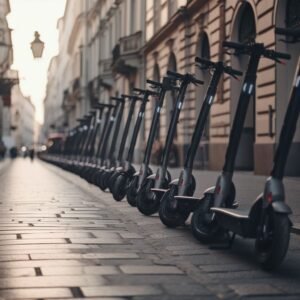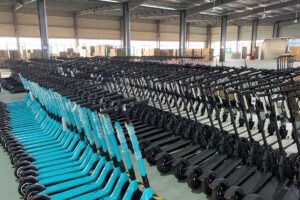In the 1990s, kick scooters with two wheels were famous in various parts of the world. Kids and adults loved the device for different purposes. The good news is that this vehicle has been trending again for some time.
The key difference is that now people use a modified form of kick scooters called electric scooters. They have the same design, such as two wheels, a handlebar, and a deck. However, they differ because the new models are motorized.
If you’re looking for more information about electric scooter motors, your search ends now. Here is a comprehensive guide to help you.
Table of Contents
- What Is The Electric Scooter Motor?
- Electric Scooter Motor Types
- How Does An Electric Scooter Motor Operate?
- Specifications You Need To Know About The Motor
- Why Should You Not Use Motor Power For Determining Scooter Efficiency?
- How Does Motor Affect Other Electric Scooter Components?
- Factors to Consider When Choosing the Motor Type of an E-Scooter
- FAQ
- Final Words
What Is The Electric Scooter Motor?
A Brief Look into the Electric Scooter Motor
Each electric scooter comes with a motor for operating smoothly. Typically, you will find this part in the hub of one or both wheels.
The motor provides power to the wheels so that you have enough force to move. The part also determines the maximum speed, acceleration, and overall performance of the vehicle.
Motor Power: What Is It?
Many people get confused when trying to understand the motor power of an electric scooter. However, the concept is not complex, as all scooters have a power rating. This is a numerical value that is provided in watts.
Each electric scooter will have a different motor rating because of various reasons. The vehicle’s power consumption determines this value. Typically, electric scooters with high power also have a greater wattage.
The wattage is the value that displays how much power your vehicle’s motor can consume. Typically, the motor will produce high mechanical power if your scooter uses more energy. The relation between these two quantities is directly proportional.
It is also better to get an electric scooter with high-listed power. This is because it will ensure excellent overall performance. For instance, your vehicle’s acceleration and hill-climbing ability will be better.
Power Range of Electric Scooter Motors Explained
The power range of an electric scooter motor is essential to understand. This will enable you to get a vehicle with the best top speed and handling. Typically, you will come across scooters ranging from 250W to 3,000W motors.
Some scooters can be more powerful than the earlier mentioned values. Typically, the range is divided according to the types. For instance, budget scooters usually have 250 to 300 watts of motor power. This type is mainly suitable for entry-level drivers.
Meanwhile, premium vehicles such as the Horizon come with 500 to 1,000 watts of power. This type is suitable for people with some scooter driving experience. Lastly, performance electric scooters have 1,200 to 3,000 watts of motor power. Advanced drivers mainly use them.
All standard electric scooters come with one motor. However, the high-performance type has two. This is why they have an exceptionally high power rating.
Electric Scooter Motor Types
Here are all the motor types you will come across when buying an electric scooter:
1, Hub Motor
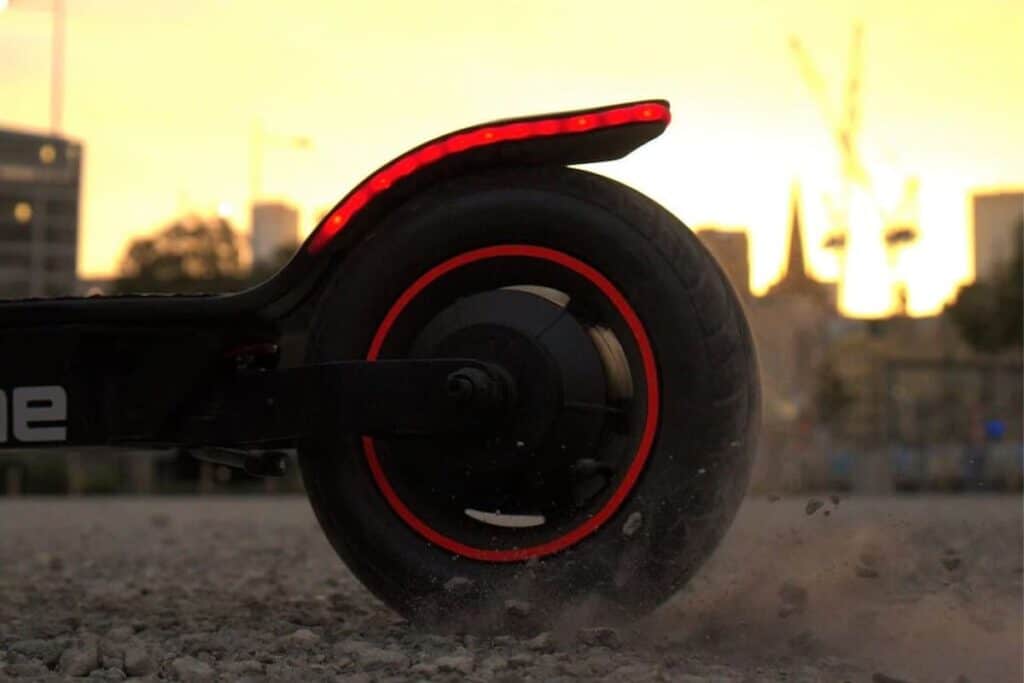
Most electric scooters you will encounter in today’s era will have one or two hub motors. As the name suggests, this part will be located in the vehicle’s wheel hub(s). The best thing is that this type is lightweight and simple.
The hub motor also has low manufacturing costs. This is why scooters of this type are relatively inexpensive. Furthermore, the system of this part is also not complex, so this motor does not face technical issues often.
Pros
- Energy-efficient design
- Cheaper than other types
- Simple system
- Easy to repair and maintain
Cons
- Lower climbing ability and maximum speed due to lack of gears
- Offers less torque
- Changing a flat tire will be complex because of the hub motor
2. Chain-Drive Motor
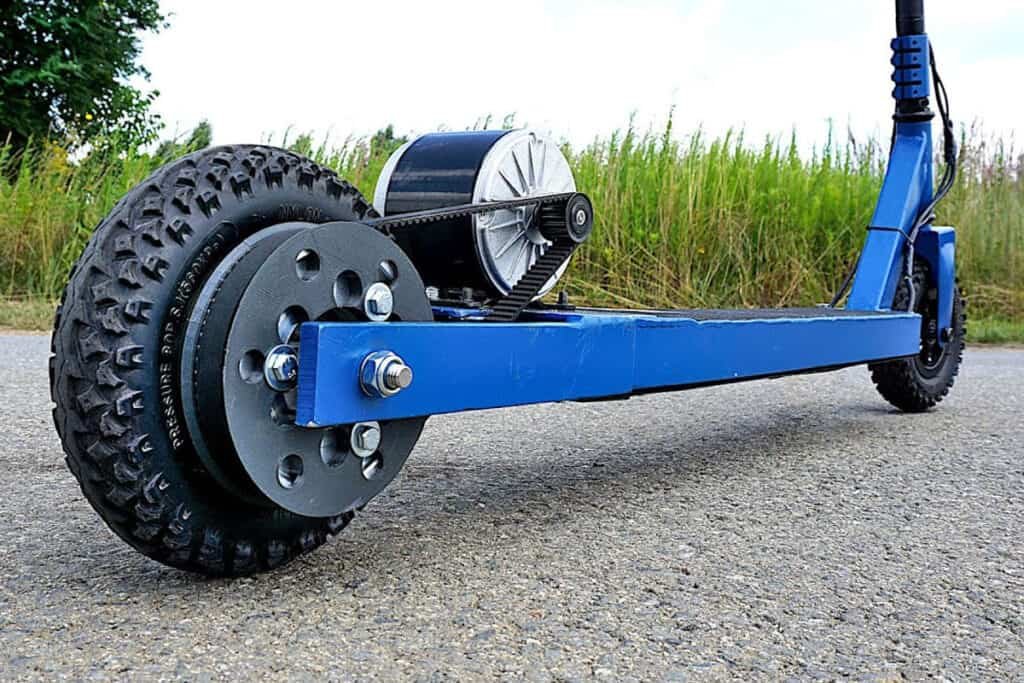
This type is also called a mid-drive motor. So you should never get confused when seeing the two terms being interchanged. The top feature of this type is that it is not located in the wheel. Instead, you will find a chain-drive motor in the deck.
This motor develops power in its locating region and transfers it to the wheels. Chains and gears help with transportation. Typically, this part drives the crank of the scooter instead of its tires.
It also increases the vehicle’s power. The primary purpose of the chain-drive motor is that it helps you maximize the scooter’s gear benefits.
Pros
- Offers more power
- High range
- Easy to service
- Makes troubleshooting simple
- Improves the scooter’s handling
Cons
- Experiences some energy loss due to friction
- Difficult to repair
- Maintaining the motor is tough
3. Brushed Motor
Before diving into the specifics of this type, you should note that electric scooters can have brushed or brushless motors. They both are DC motors but differ in operation. The former works mechanically while the latter functions electrically.
Brushed motors have been in being since the early 1800s. They are one of the oldest technologies you will come across. The top feature of this part is that it produces power through two electromagnets. One of them resembles an empty cylinder and is larger.
Meanwhile, the second magnet is within the larger one and generates magnetic fields between the two. This is used for producing power which is then transferred to the wheels. The brushed motor transport current through graphite/carbon brushes. This is the reason behind the name of this type.
Most electric scooters these days have brushless motors. This is because they provide more benefits as they are a recent technology.
Pros
- Low construction cost
- Simple controller
- Reduces the price of the scooter
Cons
- Older technology
- Wears out with time
- It becomes hazardous after prolonged use
- Production in this era is limited
4. Brushless Motor
This type is also known as BLDC in the industry. The top feature of this motor is that it is made of recent technology. Therefore, the part has a simpler operating mechanism. Besides that, it also does not use brushes for current transfer.
In this type, a digital circuit is found instead of mechanical electromagnets. The power also alternates between the motor coils for efficient functioning. Most scooters in this era will have a BLDC motor instead of the brushed part.
Pros
- Better power to weight ratio
- More energy efficient
- Operates silently
- It does not overheat often
- Highly reliable
Cons
- More expensive
- It causes some power loss
5. Sensored BLDC Motor
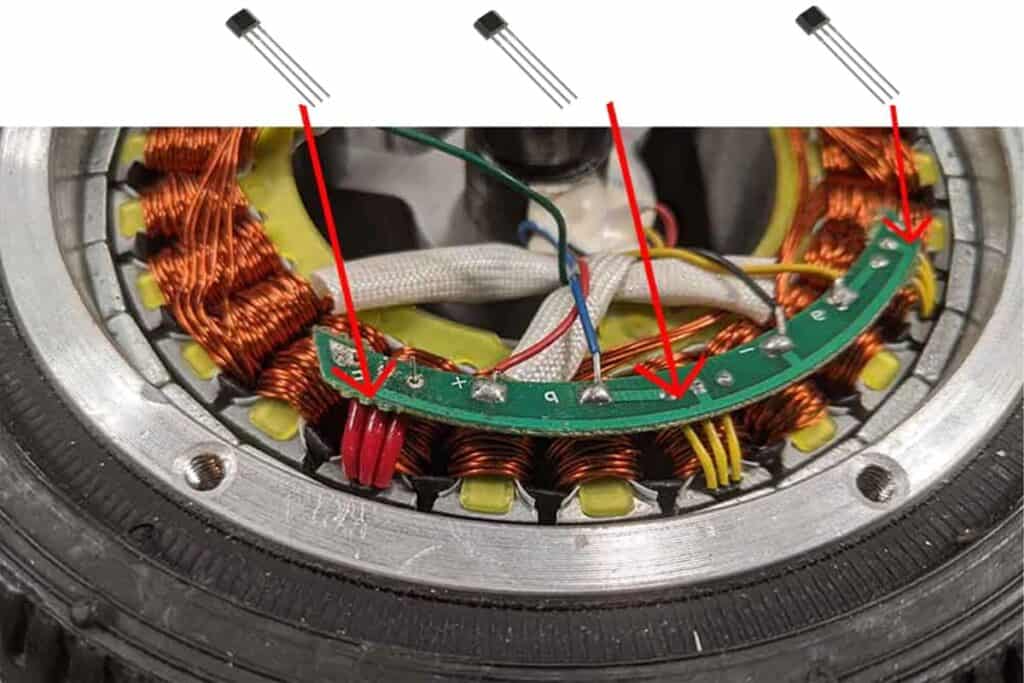
BLDC motors come in sensored and sensorless versions. The key feature of all brushless parts is that they get power from the ESC (electronic speed control). Typically, the control requires information about the rotor position for smooth motor acceleration.
The sensored BLDC contains built-in parts called the Hall Effect sensors. The controller uses them to determine the rotor position and maintain optimal speed. The sensors send information to ESC to let it know the rotor’s position.
Once the ESC understands the information, it instantly begins synchronization from zero RPM. Sensors play an integral role in the operation of this motor type. If they fail, the controller will not receive essential information.
Typically, power is transferred to the motor through three wires known as phases. These phases must be in harmony so that the scooter can operate without issues. When the sensors fail, the cables will be out of sync, and the motor will be stuck.
Pros
- Produces higher torque at lower speeds
- Excellent performance
- Widely used for vehicles that need more torque at low speeds
- Applications included electric scooters, RC cars, and much more
Cons
- Sensor failure will cause the motor to be stuck and make a grinding sound
- Sensorless BLDC will not work with this type’s controller
- Mainly useful for vehicles with high torque needs
6. Sensorless BLDC Motor
Sensorless BLDC is simply a motor that lacks brushes and sensors. This part does not contain the Hall Effect or other sensors for monitoring the rotor position. Instead, the controller uses different mechanical methods to receive essential information.
One of the top ways a sensorless BLDC controller knows rotor position is through the motor’s back EMF. Back electromotive force is simply the voltage produced by the motor. This mechanism is widespread in generators.
The top feature of sensorless BLDC motors is they are used in vehicles with low torque needs. For instance, you may find this part in multiple boats. Besides that, many airplanes also have this motor for a smooth flight. This type will also only work in vehicles with a sensorless BLDC controller.
Pros
- Longer life due to lack of Hall effect sensors
- More reliable in some cases
- Best for low torque needs
Cons
- Only provides rotor position information when the scooter is moving as no back EMF is produced in stationary vehicles
- More complex structure
7. Geared Hub Motor

Hub motors come in geared and gearless types. They are mainly used in e-bikes, but the exact differences and principles apply to electric scooters too. So let’s discuss the geared hub motor first.
A vital feature of this motor type is that it has a set of gears outside the small motor. The part is inside a casing while the gears remain outside. This motor type is relatively smaller than other hub versions and is compared with climbing motors.
The motor generates power within the casing and transfers it to the wheels through the gear system. Typically, this type is less powerful than other motors. However, the mechanism makes this part more efficient.
The geared system also tackles the common torque issues and encourages the weak motor to produce more power. Another use of this type is that it offers a higher range.
Pros
- Long range
- Power output is high
- Maintains good speed
- Highly efficient
Cons
- Experiences more wear and tear
- Short lifespan
- Requires repairs often
8. Gearless Hub Motors
The final motor type you will come across in electric scooters is the gearless hub motor. They are also called direct-drive parts and use electromagnets to cause the scooter to move forward. Firstly, you must note that the axle is the part that a motor causes to rotate to turn the wheel.
The electromagnets cause the axle to move so that the scooter can operate smoothly. The top feature of direct-drive motors is a simple inner structure.
The motor only has two essential parts called the rotor and stator. They spin automatically on one side of the component. The primary benefit of gearless type is that they also offer regenerative braking options. This motor is also called a speed motor.
Pros
- Higher maximum speeds
- Better hill-climbing angle
- Maintains speed efficiently
- Provides braking features
Cons
- Overall efficiency is low
- It makes the scooter heavy as the motor size is larger
- Wears down quickly in stop and go traffics
How Does An Electric Scooter Motor Operate?
An electric scooter’s motor operates by using the information provided by a component called the controller. This part is present in all e-scooters for efficient operations. Firstly, you have to hit the throttle on the handlebar of the vehicle.
The controller signals the scooter’s motor to work when you push the throttle. After that, the component will use energy from the battery to produce power and cause the wheels to move.
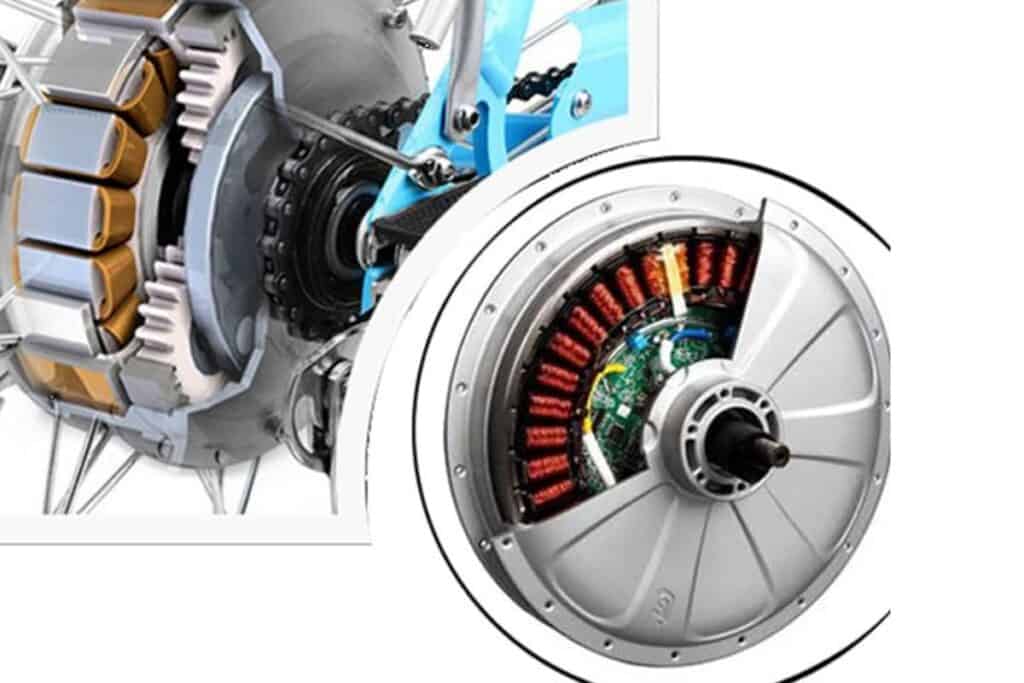
Detailed Examples of the Working of an Electric Scooter Motor
The earlier mentioned description is a simple overview of how the motor operates. However, the mechanism differs significantly depending on the motor type. This is why you may be looking for a comprehensive description.
So here is an example of how the brushless gearless DC motors work. This is the most common type you will come across in electric scooters.
Working Of A BLDC Motor

Typically, the gearless motor contains the stator and the rotor cylinders. One of them is inside the other component. The rotor is the outer part and a permanent magnet. Meanwhile, the stator is the inner cylinder and has a copper coil arrangement.
The motor works by using an interaction mechanism between the electromagnet and the permanent magnet.
When DC power is applied to the copper coil, it becomes energized and this energization of the coil causes the stator and rotor to attract each other, the rotor starts to rotate.
As the rotor turns, the energized coil loses its energy, but its neighbor coil gets energized.
The process repeats continuously so that the rotor does not stop rotating, ensuring that the motor operates smoothly and generates sufficient power to move the wheels.
Specifications You Need To Know About The Motor
The top way you can understand the quality is by knowing the motor specifications. Typically, most manufacturers list power as an essential metric. This value is the best way to determine the motor’s abilities.
Besides that, motor voltage is another functional specification represented in volts.
You will also come across revolutions or rotations per minute. Typically, companies list this metric using its abbreviation, RPM.
Torque is also a helpful specification with a Newton-meters (Nm) unit.
Electric Scooter Motor Power
As we mentioned, motor power is the top way to understand a motor’s abilities. This value determines the various performance features of your scooter.
It also impacts some of the things significantly. Here are the features that the motor power determines and affects:
- The maximum speed of the electric scooter
- Top incline angles your vehicle can climb
- The maximum weight the scooter can hold
- Range of the vehicle
Power Levels In Electric Scooter Motors
The power of adult electric scooters ranges from 80 to 12,000 watts. This range determines the maximum speed your scooter can reach. If you want a faster bike, you should choose a model with a high power level.
Most standard commuting electric scooters have a power of 200 to 500 watts. These models are best for people with a tight budget. The maximum speed for this type ranges from 25 km/h to 35 km/h. typically, half of the electric scooters today have this range.
However, heavy-duty scooters used mainly for performance and off-road driving have dual motors. These range from 1,200 to 3,000 watts. This range is for each motor in this scooter type and not a cumulative figure.
Here are other prevalent power levels that you should know:
| Power Level | Maximum Speed |
| 250 Watts | 25 km/h or less |
| 350 Watts | 25 to 35 km/h |
| 500 Watts | 40 to 60 km/h |
| 1000 Watts | 50 km/h or more |
The most powerful electric scooter model in today’s market is the Rion2 RE90. This model has a motor with a peak power of about 12,000 watts. The scooter can reach up to 160 km/h. This feature makes this model the world’s fastest e-scooter.
However, brands can mislead you when reporting the different power levels. This is why you must understand the concept of peak power. It will allow you to make a fair real vs. peak power comparison.
Peak Power Vs. Sustained Power: What’s The Difference?
Power generated by electric scooter motors varies because of various factors. These include motor temperature, external environment, road obstacles, and much more. The component’s temperature affects its performance considerably. Typically, a motor becomes less efficient when it overheats.
You must understand that peak power is the maximum power a motor can take in indefinitely for a short period before overheating. The scooter will operate using full power in a perfect world with no road obstacles and optimum temperature. This is what the peak power indicates.
Of course, we don’t live in a perfect world. This is why using peak power as a metric is misleading. Typically, the levels your scooter consumes on the road are its real or sustained power. The actual value is mainly 30% to 90% of the peak figure.
On average, the real power of most scooters is 57% of the peak value. Unfortunately, most brands list the peak levels in their specifications to mislead customers. They also don’t mention the term “peak,” so you can never accurately know what the power value indicates.
Continuous or sustained power is the better metric to help you decide when buying an e-scooter. It is the maximum power your vehicle can consume when operating for an indefinite time. This value indicates how much energy the scooter’s motor can handle continuously.
What Is The Motor Torque In Electric Scooters?
The motor torque is the twisting force your scooter’s motor produce to rotate the wheel and help you move forward. In some countries such as the UK, this value is measured using the imperial system in a pound-foot unit (lb-ft).
Meanwhile, the US and other North American countries use the SI unit system. This means that the measurement unit for these places is Newton-meters (Nm). The torque plays an integral role in determining your scooter’s maximum speed and incline angle.
Besides that, the torque also determines the amount of work an electric scooter’s motor can do. Unfortunately, most brands don’t provide this useful metric in their specifications list. However, you can still calculate it using a simple physics formula.
Typically, you should multiply the vehicle’s power by revolutions per second. Simply put Torque = RPS x Power.
Why Should You Not Use Motor Power For Determining Scooter Efficiency?
Many of you may be considering only the motor when buying electric scooters. However, this part does not tell you the whole story. You will have to consider other factors to make an informed buying decision.
The motor power or wattage only indicates how much power the component can consume. Generally, a motor that uses high energy quickly produces more mechanical power. This means that the part will have a high wattage.
Typically, high wattage means the scooter will accelerate faster, hold higher maximum weight, move more quickly, and climb hills easily. However, the value will not tell you the efficiency of the motor. This is why power is not the best metric for determining the performance of electric scooters.
You should never expect motors with similar wattages to have the same performance. This is because one of them can be more efficient. For instance, two motors with a 250 watts rating will consume the same electric power. However, that does not mean that their outputs and efficiency will be the same.
A test by the ESG has proved this conclusion. In the study, Xiaomi M365 with a continuous power of 250 watts was compared with XR Ultra and Segway Ninebot ES motors. Both the models had a capacity of 300 watts.
However, the results showed that Xiaomi M365 is faster than the other scooters. It covered 15 miles per hour in 6.3 seconds. Meanwhile, XR Ultra covered the same distance of 7.8 seconds, and the Segway model took 7.1 seconds.

So you should note that motor power will never give you an accurate performance indication. Most brands also don’t mention the vehicle’s efficiency in the specifications, and you cannot calculate it.
Today, most electric scooters have a maximum efficiency ratio of not more than 50 to 60%. So you should not use wattage to make a direct comparison between two scooters.
The best way to make a fair comparison is by considering other factors. For instance, you should consider the motor powers, maximum speeds, and accelerations to get a better idea.
How Does Motor Affect Other Electric Scooter Components?
Motors with high power will increase the battery size of your scooter. This means that the model will be heavier than those with low power. Besides that, bigger batteries also mean that the scooter will take more time to charge.
Besides that, you should ensure that the motor type and controller type are the same. For instance, a sensorless BLDC motor will only operate in a device with a sensorless BLDC controller.
Factors to Consider When Choosing the Motor Type of an E-Scooter
Do you require an electric scooter for everyday commuting needs? If so, you should not choose a model with less than 300 watts of power. This is because you will not be able to travel on steep hills.
Besides that, low power also means that your scooter will not operate well on rough terrains. Another thing you should consider is your weight when choosing the motor type. You should get a scooter with a high power rating if you are a plus-sized individual.
Typically, a high power rating ensures that the scooter will need a bigger battery. This contributes to the vehicle’s weight and increases its maximum holding capacity.
FAQ
Here are the answers to the most frequently asked questions about electric scooter motors:
What Should I Do If My Scooter Motor Fails?
A motor is the most reliable part of an e-scooter. If it is not rotating, your vehicle may be experiencing a battery issue. A problem with the controller can also cause your motor to fail. Typically, you should get the scooter checkout by a technician.
Can I Tune-Up My Electric Scooter’s Performance At Home?
In today’s digital era, you can easily find hacks to adjust your scooter’s controller and improve its performance. However such tune-ups reduce your vehicle’s battery life. It will also decrease the maximum distance you can travel. So while you can tune up the scooter, it is not advisable to do so.
Do Two Motors With Same Wattage Have Equal Performance?
The sustained power rating is an excellent way to determine the performance of your scooter. However, it is not suitable for comparing two different models. This is because the mechanical power output of both scooters will vary depending on various factors.
A prime example that will help you understand is our test between the Turboant X7 Pro and Apollo Light scooters. Both models have a power rating of 350 watts. However, the latter can reach a maximum speed of 36 km/h. Meanwhile, X7 Pro’s top speed is 31.4 km/h.
Besides that, Apollo Light can cover a 0 to 15 MPH distance in 5 seconds. Meanwhile, the other scooter requires 7.3 seconds to cover the same distance. So you should never consider two models with the same wattage to perform equally.
Typically, you should consider various factors to get an idea of the efficiency. For instance, you must understand each scooter’s acceleration, maximum speed, and motor power.
Final Words
This is everything you need to know about the motors of electric scooters. When buying your best model, you must consider various factors to make an informed decision. These include the motor’s power, maximum capacity of the scooter, weight, and much more.
Once you understand the motor system of an electric scooter, you can easily choose the suitable model for your commuting or racing needs. So be sure to read this guide thoroughly.




